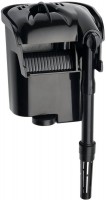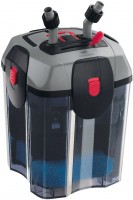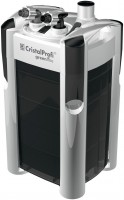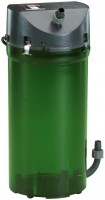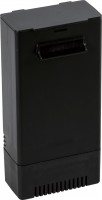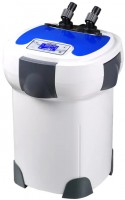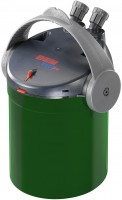Aquarium Filters Aquael
All Aquarium Filters Advanced filters → |
You might be interested in
Aquarium Filters: specifications, types
Type
- External. Filters placed outside the aquarium. As a rule, they are characterized by high performance and are designed to filter large volumes of water. In the category of external filters, canister subtype models predominate, which are installed separately from the aquarium. Less common are mounted specimens, suspended on the outer wall of the aquarium.
- Internal. Filters installed inside the aquarium. The vast majority of them are designed for purifying small and medium volumes of water. Suction is usually carried out at the bottom of the filter, then the water passes through the filter element (foam rubber or synthetic wool) and is then released at the top of the filter. The emerging stream is directed to the surface of the water, thereby effectively enriching it with oxygen. Such filters are often attached to the inner glass with special hooks or suction cups.
- Cascade. A type of filter that is attached to the outer wall of the aquarium. The container with filter cartridges in their design is located outside the tank. Water from the aquarium enters the container through the inlet manifold, is filtered and drained back through a kind of overflow in the form of a waterfall. This overflow option creates a visually attractive flow effect in the aquarium and minimizes internal flow, which is important for some types of freshwater fish. The aeratio...n of water in cascade filters is superficial - the air is saturated with oxygen by mixing water with air when passing through a “waterfall”.
- Donny. Filters installed at the bottom of the tank. Aquarium soil is used here as a filter material, so it is extremely important to take into account the particle size of the substrate and the depth of the bottom filter. It is also worth considering the location of the aquarium decorations and the dense roots of plants - they can prevent water from passing through the pores of the filter, forming “dead zones” where silting will occur.
- Airlift. A type of internal filter for an aquarium, the principle of which is to use the lifting force of air - it is supplied to the lower part through a tube, passes through the filter element (usually a sponge) and returns back through the upper part of the filter housing. This ensures not only water purification, but also its saturation with oxygen. The air supply is carried out using a compressor located outside the aquarium.
— Skimmer. Skimmers are used to remove bacterial film from the surface of water; they also effectively remove organic contaminants. Such films are formed due to food residues, oil, fish secretions and other organic substances. Skimmers are often used in saltwater aquariums, and in some cases they are also used in freshwater tanks where there are problems with film and contamination of the water surface. Note that skimmers are an auxiliary element of filtration and are used in conjunction with other aquarium filters.
— For a marine aquarium. Filters for use in marine or reef aquariums. They are designed to meet the specific needs of marine animals and corals, and the main focus of these marine aquarium filters is to maintain proper salt water quality to ensure the health and prosperity of the inhabitants.
- Internal. Filters installed inside the aquarium. The vast majority of them are designed for purifying small and medium volumes of water. Suction is usually carried out at the bottom of the filter, then the water passes through the filter element (foam rubber or synthetic wool) and is then released at the top of the filter. The emerging stream is directed to the surface of the water, thereby effectively enriching it with oxygen. Such filters are often attached to the inner glass with special hooks or suction cups.
- Cascade. A type of filter that is attached to the outer wall of the aquarium. The container with filter cartridges in their design is located outside the tank. Water from the aquarium enters the container through the inlet manifold, is filtered and drained back through a kind of overflow in the form of a waterfall. This overflow option creates a visually attractive flow effect in the aquarium and minimizes internal flow, which is important for some types of freshwater fish. The aeratio...n of water in cascade filters is superficial - the air is saturated with oxygen by mixing water with air when passing through a “waterfall”.
- Donny. Filters installed at the bottom of the tank. Aquarium soil is used here as a filter material, so it is extremely important to take into account the particle size of the substrate and the depth of the bottom filter. It is also worth considering the location of the aquarium decorations and the dense roots of plants - they can prevent water from passing through the pores of the filter, forming “dead zones” where silting will occur.
- Airlift. A type of internal filter for an aquarium, the principle of which is to use the lifting force of air - it is supplied to the lower part through a tube, passes through the filter element (usually a sponge) and returns back through the upper part of the filter housing. This ensures not only water purification, but also its saturation with oxygen. The air supply is carried out using a compressor located outside the aquarium.
— Skimmer. Skimmers are used to remove bacterial film from the surface of water; they also effectively remove organic contaminants. Such films are formed due to food residues, oil, fish secretions and other organic substances. Skimmers are often used in saltwater aquariums, and in some cases they are also used in freshwater tanks where there are problems with film and contamination of the water surface. Note that skimmers are an auxiliary element of filtration and are used in conjunction with other aquarium filters.
— For a marine aquarium. Filters for use in marine or reef aquariums. They are designed to meet the specific needs of marine animals and corals, and the main focus of these marine aquarium filters is to maintain proper salt water quality to ensure the health and prosperity of the inhabitants.
Recommended aquarium volume
The volume of the aquarium in liters in which the filter will ensure proper water purification performance. This parameter is usually indicated approximately, because when choosing an aquarium filter, it is important to take into account other factors: the degree of population of the monastery for underwater inhabitants, the size of the fish, etc.
Container
The volume of the container for bulk materials and other fillers in the design of the aquarium filter. As a rule, such containers are made of plastic with transparent or translucent walls, through which you can visually view dirt and the filter filling level. The larger the container, the more materials can be used, which usually increases filtration efficiency.
Filter
- Mechanical. Filters for purifying aquarium water from solid suspensions: food debris, fish waste products, debris, sand and other small particles. The mechanical type of filtration keeps the water clean and clear, improving the visual appearance of the aquarium and reducing the concentration of solid particles in it. As a rule, such filtration is carried out by sponges with different pore sizes.
— Multi-level. Models that have several levels of filtration at once. Most often, multi-level filters perform mechanical and biological water purification (removing solid particles from it, as well as decomposition products of organic substances). Advanced aquarium filters also provide chemical filtration - water purification using chemicals and adsorbents (for example, activated carbon).
— Filter volume. The volume of the internal filter container in which filter materials and water purification mechanisms are placed. The parameter is measured in liters and indicates how much water the filter can hold during operation. The larger the volume, the better the filtration efficiency, so you can extend the interval between cleaning the aquarium.
— Number of baskets. The number of baskets containing different filter materials. It can vary from one to three, less often - up to four or five. A large number of baskets are provided in complex filtration systems, which often include additional s...tages of water treatment: ultraviolet treatment, water heating, etc.
— Multi-level. Models that have several levels of filtration at once. Most often, multi-level filters perform mechanical and biological water purification (removing solid particles from it, as well as decomposition products of organic substances). Advanced aquarium filters also provide chemical filtration - water purification using chemicals and adsorbents (for example, activated carbon).
— Filter volume. The volume of the internal filter container in which filter materials and water purification mechanisms are placed. The parameter is measured in liters and indicates how much water the filter can hold during operation. The larger the volume, the better the filtration efficiency, so you can extend the interval between cleaning the aquarium.
— Number of baskets. The number of baskets containing different filter materials. It can vary from one to three, less often - up to four or five. A large number of baskets are provided in complex filtration systems, which often include additional s...tages of water treatment: ultraviolet treatment, water heating, etc.
Power
The power level, measured in watts, determines the energy consumption of the filter and/or its components (compressor, fan, etc.). This parameter indicates how much electricity the filter “winds” during operation and is not directly related to its filtration performance (see below).
Performance
The volume of water that the filter is able to process and purify per unit of time. Often this parameter is measured in liters of water per hour. Filter performance is directly related to the recommended aquarium size. It is customary to ensure that the flow rate of liquid passing through the filter in one hour exceeds the volume of the reservoir at least three times. Thus, for a conventional aquarium with a volume of 200 l, the recommended filtration capacity should be at least 600 l/h.
Power adjustment
Possibility of adjusting the flow of water passing through the filter. In practice, this is often achieved by rotating a special valve or diffuser at the inlet or outlet of the filter. Adjusting the power can be useful to tailor the filter to the specific needs of the aquarium and underwater inhabitants.
Water flow adjustment
The ability to choose the optimal direction of water flow at the filter drain relative to the water surface. Adjusting the flow angle ensures an even distribution of oxygen and nutrients, and also creates a suitable water flow, simulating conditions in the natural habitat of fish. At the same time, by correcting the direction of the water, it is possible to prevent the accumulation of debris and deposits of contaminants in certain areas of the aquarium.
spray bar
A sprinkler is a long tube with holes or slots through which water is released back into the aquarium after the filtration process. Visually, such a pipe resembles a flute, which is why it is often called that. Such sprayers form a stream of water that is distributed along the entire length of the flute, ensuring its uniform circulation. Also, the sprinkler can reduce the water flow rate, which is useful for aquariums with delicate fish or plants.
Noise level
The noise level in decibels produced by the filter or its components during operation. The lower this indicator, the more comfortable the operation of the filter will be and the better it is suitable for rooms where silence is important (for example, when placing an aquarium in the bedroom). At the same time, even in the loudest models, the noise level usually does not exceed 40 dB - this is comparable to the rustling of leaves on trees with a weak breeze.
Country of brand origin
Country of origin of the brand under which the products are presented on the market. Often indicated by the nationality of the company or the location of its headquarters. However, the actual production capacity of a brand often differs from its country of origin.
Let us note that the quality of products depends not so much on geography, but on the specific organization of processes and quality control at all stages of production. Therefore, national prejudices regarding brands from certain regions, as a rule, are not supported by anything. It is necessary to pay attention to the country of origin of a brand only if the goal is to fundamentally support or bypass a manufacturer from a specific country.
Let us note that the quality of products depends not so much on geography, but on the specific organization of processes and quality control at all stages of production. Therefore, national prejudices regarding brands from certain regions, as a rule, are not supported by anything. It is necessary to pay attention to the country of origin of a brand only if the goal is to fundamentally support or bypass a manufacturer from a specific country.




